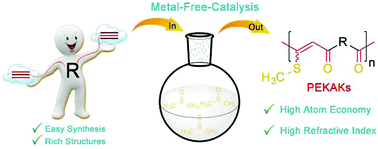Synthesis and characterization of poly(ethene–ketone–arylene–ketone)s containing pendant methylthio groups via metal-free catalyzed copolymerization of aryldiynes with DMSO†
Abstract
A series of methylthio-substituted poly(ethene–ketone–arylene–ketone)s were synthesized by metal-free catalyzed copolymerization between aromatic diynes and dimethyl sulfoxide (DMSO). The copolymerization can be easily carried out under catalysis by I2 and BF3·Et2O in N,N-dimethyl formamide at 100 °C, resulting in good yields (up to 90.9%) and high molecular weights (Mw up to 13 100). Moreover, the effect of different substituents on the diyne monomers on the Mw, yield and solubility of the resultant polymers was investigated. All these polymers were well characterized by GPC, NMR, and FTIR, and their structures were confirmed. The obtained polymers showed high thermal stability and had high char yields at 800 °C. Moreover, most of the polymers had a high refractive indices of visible light (400 to 800 nm) due to their high sulfur contents. Given the high efficiency, monomer versatility, and excellent performance of the resultant products, this metal-free catalyzed copolymerization between diynes and DMSO opens up new opportunities to prepare advanced functional polymers.



 Please wait while we load your content...
Please wait while we load your content...